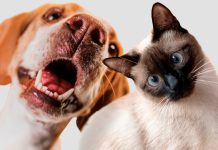People and their pets are living longer with better health care, nutrition, and improved living conditions. I see pets in their late teens regularly, and geriatric medicine is advancing in leaps and bounds. Never dismiss changes in your older pet as “just old age”, rather investigate, this may be something we can treat. Quality of life for both us and the furry ones should always be our objective.
Annual physical examinations and even sometimes bi-annual examinations are necessary. Veterinarians discuss exercise tolerance, travel, changes in food and water consumption as they examine your pet for masses, aches and pains, and anything else that raises concern. Examination includes a dental exam for fractured or infected painful teeth that can affect other organ systems. Good health care starts with the examination and may extend to further testing including bloodwork, urinalysis, x-rays, and ultrasounds.
Diet is another cornerstone of any older pet’s health needs. Don’t justify weight gain by saying “but treats are all he enjoys now”. An obese pet has difficulty moving, arthritic joints have to work harder, and stress is placed on all systems including the heart, lungs, liver, and kidneys. It’s easier if a pet is lean and not wheezing with exertion.
Consider a geriatric diet around eight to ten years of age in cats and small dogs, and in large dogs earlier. Specific diets have been formulated for many medical problems. Some diets are formulated for joints and include products for enhanced mobility and to slow the progress of degenerative joint disease. There is even a diet to try and slow the progress of canine dementia. Pets that seem confused, have abnormal sleep cycles, and accidents in the house may be experiencing dementia or cognitive dysfunction associated with old age.
Unlimited water is imperative in the elderly pet. If your pet begins to drink and urinate excessively this is an early symptom of many serious, but often treatable, geriatric diseases.
People use physiotherapy or try alternative therapies for aches and pains. These therapies are equally beneficial to our pets. Old bodies get relief with heat packs, massage, range of motion exercises, and physiotherapy. Acupuncture, cranio-sacral therapy, chiropractic medicine, and numerous herbal and homeopathic formulas are used successfully to treat old joints, muscles and bone. To this end remember five or ten minutes gentle exercise three times daily is preferable to forty minutes of intense exercise with fragile pets. Like you, pets stiffen up and hurt! Older pets also have a reduced tolerance for heat and cold extremes.
Aged pets find it more difficult to groom and may need help. Cats may not be able to contort themselves to reach places on their backs and hind end and fur can become matted. Older pets may become crankier if sore, and some are more easily startled if their hearing and sight is failing. These pets need closer supervision outside the home, and protection from small children startling or pouncing on them.
Remember the benefits of the human animal bond has been credited with extending our lives and quality of our lives too. We need our old pets as much as they need us, but also remember senior pets deserve gentle retirement. If all of your best efforts can no longer keep your friend comfortable and there are more sick days than not, it may be time to say good-bye. This is the least selfish thing you will ever do for an old loved companion.








